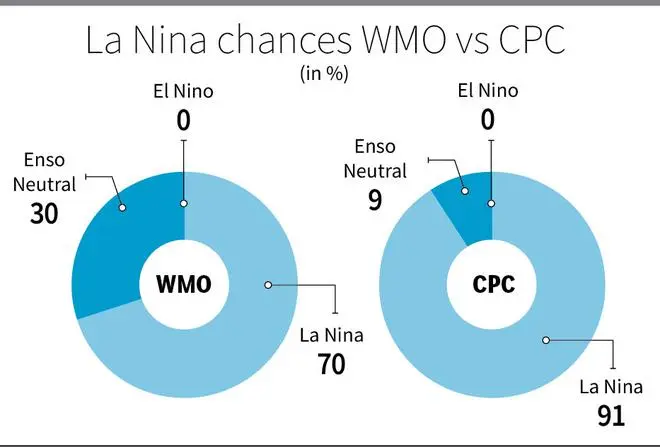La Nina, a weather event that leads to heavy rainfall in the Indian Ocean region particularly India and leads to dry weather and drought in the US and South America, is underway in the Pacific Ocean, the Australian Bureau of Meteorology has said.
This is the third consecutive year that La Nina, which has caused unseasonal rainfall in India in 2020 and 2021, is setting in, most likely by this month, and some economists fear that it could cause a $1 trillion loss to the global economy by the end of 2023.
The losses could be through heavy rains, flooding, resultant damages to infrastructure, farms, crops and the need to set right the damages.

Criteria met
Australian Bureau of Meteorology head of long-range forecasts Andrew Watkins said the La Nina is underway and eastern Australia should be prepared for above-average rainfall over the next three months. For India, the forecast for September is above-normal rainfall.
Watkins said the La Nina criteria have been met, though most models forecast the event to be weak to moderate in strength, peaking over the next couple of months before easing around December.
Earlier, the Climate Prediction Centre (CPC) of the US said La Niña was likely to continue through Northern Hemisphere winter 2022-23, with a 91 per cent chance in September-November, decreasing to a 54 per cent chance in January-March 2023.
1st triple dip event
The World Meteorology Organisation (WMO) said the La Nina would continue over the next six months with a 70 per cent chance in September-November but gradually decreasing to 55 per cent in December-February.
“It is likely that the protracted La Niña event will last until at least the end of the year, becoming this century’s first “triple-dip“ La Niña, spanning three consecutive northern hemisphere winters,” it said.
The WMO said chances of an El Nino developing were zero. El Nino results in drought and dry weather in Asia, particularly the Indian Ocean region.
Human-induced change
The WMO is blaming “human-induced climate change” resulting in the rise of global temperatures, which in turn has led to impacting seasonal rainfall and temperature patterns.
The setting in of La Nina, according to the Food and Agriculture Organisation, can lead to crop losses and food insecurity in Asia. Countries in the Pacific and the Great Horn of Africa will also be affected due to La Nina, which can cause heavy rain and flooding in some parts of the world and drought in others.
Parts of Asia that face risks are Afghanistan, Iran, Iraq and Pakistan, the Philippines, Indonesia and North Korea. However, a confirmation from the FAO is awaited on this.
Over the last two years, the La Nina effect had affected crops in South America and the US. In South America, the soyabean crop was affected in 2020 resulting in edible oils prices soaring.
Impact on India
Last year, the yield of the oilseed crop was 10 per cent lower in Brazi, while in some regions it was lower by 40 per cent. In the US, the yield of wheat and corn harvested now is reported to be low. The Texas region has been affected by dry weather, resulting in the cotton crop being affected this year.
India benefited from the 2020 La Nina as its agricultural exports increased with the Covid pandemic and the Centre’s response to meet to increased demand aiding higher shipments.
In 2020, India experienced heavy rains in September-October, while last year, it received unseasonal rainfall during October-November that extended to the first week of December. This helped improve sugarcane yield, though cotton production was affected.
The problem now
The problem with La Nina this time is that it comes at a time when many countries face the risk of recession in view of the Ukraine War pushing up costs, leading to inflation and consequent hike in bank rates, analysts said.
Also, countries such as China, Pakistan and Bangladesh are facing trouble on the food security front with heatwave and unprecedented rains affecting standing crops. All these could cumulatively cost the global economy millions of dollars over the next few months, according to analysts.






Comments
Comments have to be in English, and in full sentences. They cannot be abusive or personal. Please abide by our community guidelines for posting your comments.
We have migrated to a new commenting platform. If you are already a registered user of TheHindu Businessline and logged in, you may continue to engage with our articles. If you do not have an account please register and login to post comments. Users can access their older comments by logging into their accounts on Vuukle.